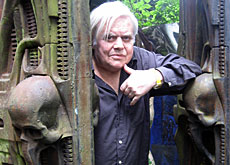
In Zurich no one can hear you scream

Cult Swiss artist and designer HR Giger, the visual effects star behind the sci-fi horror film Alien, is holding a retrospective in Switzerland of his early work.
swissinfo visited Giger, a modern-day Hieronymus Bosch, at his Zurich home to discuss his early influences and the new exhibition.
The “Beware of the dog” plaque on the Swiss horrormeister’s front door sounds very ominous. Suddenly the door opens, a cat creeps out and a white-haired old man dressed in black beckons me in.
“Sorry about the mess. We’ve had lots of guests over from the States for the exhibition,” says Giger, clearing books and empty cups from his jet-black office decorated with his distinctive monochromatic airbrushed images, skulls and his “Harkonnen” skeletal bucket seats.
The art museum in Chur – Giger’s hometown in eastern Switzerland – is currently organising a retrospective of its local master of fantastic art, looking back at Giger’s early work from 1961 to 1976, before he shot to fame on the back of Ridley Scott’s Alien.
The museum organisers are keen to show that there is more to their surreal local star than his Oscar-winning space monsters.
“Giger’s early creations are the foundation of his entire later work,” said Beat Stutzer, the director of Chur’s Bündner Kunstmuseum.
“His fantastical realism has secured him an independent and non-conformist position within the art scene. But in terms of its artistic content and significance, his work is underestimated.”
This sentiment is echoed by horror legend Clive Barker: “To simply characterise Giger as ‘The artist of Alien’ is like calling Michelangelo the set designer for [the film] The Agony and the Ecstasy.”
The exhibition features examples of Giger’s early ink drawings, oil paintings and sculptures, alongside works by artists such as Francisco José de Goya and Giovanni Battista Piranesi.
This helps position Giger’s work within the small “art history of horror”, adds Stutzer.
Idyllic shadowy childhood
Giger says he had a “wonderful childhood” that was “full of mysteries and romantic places”.
So what drove the young Hansruedi, son of a pharmacist, to develop a fascination for all things dark and strange?
“The places I liked the most were the dark ones,” Giger explained. “As soon as I could dress myself I wore black.”
At the age of eight he had “one of the most intense experiences” of his life when he came across an Egyptian mummy and sarcophagus in a Chur museum.
“I often went alone to the museum on Sunday mornings,” he adds.
He also used to take pleasure in showing friends his homemade ghost train and later discovered a taste for jazz, which he played with friends in his “black room”.
Despite an idyllic childhood, Giger was, in his own words, “a horrible student”. So after discovering a talent for drawing, his parents encouraged him to study industrial design at the School of Applied Arts in Zurich.
Nightmarish influences
At art school a whole new world opened up; he became interested in Sigmund Freud and kept a diary of his dreams. Later he suffered from night terrors, and many of his creations are largely inspired by this sleep disorder.
Ongoing issues, such as genetics, overpopulation, collective angst about the Cold War nuclear arms race and fear of robots taking over society, also influenced his choice of subjects.
“And death and eroticism have always been important elements of my work,” adds Giger.
His early artistic influences included painters Ernst Fuchs and Salvador Dali, both of whom he met later in life.
Throughout the 1970s he refined his airbrush skills – “the perfect tool for surrealistic work” – creating monochromatic paintings of nightmarish landscapes and strange fantasies of human bodies and machines – known as biomechanics.
The period at the Chur exhibition ends in 1976, just before Giger rose to worldwide stardom with Alien, a film he is “rather tired of talking about”.
Giger has since put down his airbrush. Today, alongside promoting his museum in Gruyères, he continues to design and put his name to various weird and wonderful projects from rock guitars to Alien backscratchers.
“I always have something to do,” explains the 67-year-old horrormeister.
swissinfo, Simon Bradley in Zurich
Giger was born in Chur, canton Graubünden in February, 1940.
He studied architecture and industrial design at Zurich’s School of Applied Arts.
He began work as an interior designer in 1966, before becoming a full-time artist and filmmaker in 1968.
In 1978 Giger began work on Ridley Scott’s film Alien, sculpting most of the creatures and sets, earning him an Oscar two years later.
The exhibition HR Giger – Works before “Alien” (1961-1976) is being held at the Bündner Kunstmuseum Chur from June 30 to September 9, 2007.
The museum is open from Tuesday to Sunday (10am-5pm).

In compliance with the JTI standards
More: SWI swissinfo.ch certified by the Journalism Trust Initiative















![The four-metre-long painting "Sonntag der Bergbauern" [Sunday of the Mountain Farmers, 1923-24/26] had to be removed by a crane from the German Chancellery in Berlin for the exhibition in Bern.](https://www.swissinfo.ch/content/wp-content/uploads/sites/13/2025/12/01_Pressebild_KirchnerxKirchner.jpg?ver=a45b19f3)














You can find an overview of ongoing debates with our journalists here . Please join us!
If you want to start a conversation about a topic raised in this article or want to report factual errors, email us at english@swissinfo.ch.